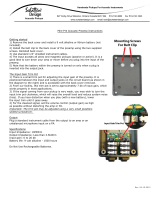
www.fi shman.com
Fishman and Fishman Transducers are trademarks or tradenames of Fishman Transducers Inc. 513-300-217 Rev. 1, 8-14
FCC Compliance Notice
This equipment has been tested and found to comply with the limits for a Class B digital device, pursuant to Part
15 of the FCC Rules. These limits are designed to provide reasonable protection against harmful interference
in a residential installation. This equipment generates, uses, and can radiate radio frequency energy and, if not
installed and used in accordance with the instructions, may cause harmful interference to radio communications.
However, there is no guarantee that interference will not occur in a particular installation. If this equipment does
cause harmful interference to radio or television reception, which can be determined by turning the equipment
off and on, the user is encouraged to try to correct the interference by one or more of the following measures:
– Reorient or relocate the receiving antenna.
– Increase the separation between the equipment and receiver.
– Connect the equipment into an outlet on a circuit different from that to which the receiver is connected.
– Consult the dealer or an experienced radio/TV technician for help.
NOTE: Fishman Transducers, Inc. is not responsible for unauthorized equipment modi -
cations that could violate FCC rules, and/ or void product safety certi cations.
EU Declaration of Conformity CE: Hereby, Fishman declares that this Platinum Pro EQ is in com-
pliance with the essential requirements and other relevant provisions of Directive 2004/108/EC.
Copyright © 2014 FISHMAN TRANSDUCERS, INC.
All rights reserved. No part of this document may be reproduced in any form without
the written permission of FISHMAN TRANSDUCERS, INC.

















